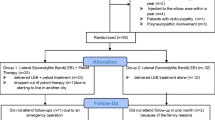Abstract
Objective
To observe the clinical effect of superficial needling for intractable humeral epicondylitis.
Methods
Sixty cases in conformity with the inclusion criteria of intractable humeral epicondylitis were randomly divided into two groups, 30 cases in each. The cases in the superficial needling group were treated by superficial needling plus moxibustion, while those in the electroacupuncture (EA) group were treated by EA plus moxibustion. After treatment, the improvement of the clinical symptoms and signs were compared between the two groups.
Results
The curative rate was 80.0% and the total effective rate was 96.7% in the superficial needling group. The curative rate was 60.0% and the total effective rate was 83.3% in the EA group. The differences in the clinical effects between the two groups were statistically significant (P<0.05).
Conclusion
The therapeutic effect of superficial needling plus moxibustion for intractable humeral epicondylitis is better than that of EA plus moxibustion.
Similar content being viewed by others
References
Cai YM, Huang WY, Zheng JF. Clinical study on the treatment of lateral humeral epicondylitis by wheat-grain moxibustion plus acupuncture. Shanghai Zhenjiu Zazhi, 2012, 31(10): 746–747.
Zheng ZJ. Clinical observation on Ashi point injection of ozone for tennis elbow. J Acupunct Tuina Sci, 2009, 7(6): 347–348.
Zhang RX, Yu Z. Observation on the efficacy of auricular point plaster therapy plus acupuncture and moxibustion in treating external humeral epicondylitis. Shanghai Zhenjiu Zazhi, 2013, 32(2): 126–127.
Ye MZ. Contralateral needling method and its applications in treating upper-limb pain. J Acupunct Tuina Sci, 2012, 10(1): 58–61.
State Administration of Traditional Chinese Medicine. Criteria of Diagnosis and Therapeutic Effects of Diseases and Syndromes in Traditional Chinese Medicine. Nanjing: Nanjing University Press, 1994: 189–190.
Liu YP, Liu Y. Diagnostic Classification and Standard of Functional Evaluation of Damage and Diseases of Bone and Joint. Beijing: Tsinghua University Press, 2002: 204.
Liu ZL, Pan QJ. Observations on the efficacy of superficial needling therapy for tennis elbow. Shanghai Zhenjiu Zazhi, 2011, 30(10): 693–694.
Shen DG. Introduction of a good method for treating painful diseases: electric superficial acupuncture. Shanghai Zhenjiu Zazhi, 2006, 25(2): 32–33.
Xu RZ, Wang MP. Study on the traditional Chinese medicine theory of floating acupuncture therapy. Zhonghua Zhongyiyao Zazhi, 2009, 24(9): 1171–1173.
Wu HG, Yan J, Yu SG, Xu B, Chang XR, Ma XP, Mu JP, Liu HR. Research current situation and development trend of moxibustion therapy. Shanghai Zhenjiu Zazhi, 2009, 28(1): 1–6.
Chen XH, Zhang GY, Zhou MQ, Zheng J. Analysis and study on modern pharmacy and pharmacology of moxibustion. Zhongguo Zhenjiu, 2009, 29(5): 428–430.
Author information
Authors and Affiliations
Corresponding author
Rights and permissions
About this article
Cite this article
Zhang, Dy., Song, Hy. Observation on clinical effect of superficial needling for intractable humeral epicondylitis. J. Acupunct. Tuina. Sci. 11, 322–325 (2013). https://doi.org/10.1007/s11726-013-0719-9
Received:
Published:
Issue Date:
DOI: https://doi.org/10.1007/s11726-013-0719-9
Key Words
- Tennis Elbow
- Superficial Needling
- Electroacupuncture
- Acupuncture Therapy
- Moxibustion Therapy
- Suspended Moxibustion




